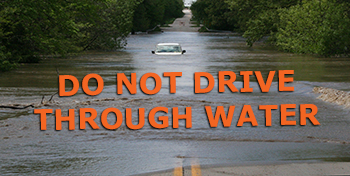The Impact of Floodwaters: Understanding the Risks and Precautions
Floodwaters can have devastating effects on communities, infrastructure, and the environment. When heavy rainfall or melting snow causes rivers, lakes, or oceans to overflow their banks, floodwaters can quickly inundate homes, roads, and businesses.
One of the primary risks associated with floodwaters is the potential for property damage. Water intrusion can lead to structural weakening of buildings, electrical hazards, and contamination from sewage or chemicals carried by the floodwater. In addition to property damage, flooding poses significant health risks due to the presence of bacteria, viruses, and other pathogens in the water.
It is crucial for individuals living in flood-prone areas to take precautions before, during, and after a flood event. Some important safety measures include:
- Creating an emergency plan that includes evacuation routes and contact information for local authorities.
- Securing important documents and valuables in waterproof containers or safe deposit boxes.
- Avoiding walking or driving through floodwaters as they may be deeper or faster-moving than they appear.
- Taking steps to prevent mold growth by drying out affected areas within 24-48 hours after flooding subsides.
- Seeking medical attention if you come into contact with contaminated floodwater to prevent illness.
By understanding the risks associated with floodwaters and taking proactive measures to mitigate them, individuals can better protect themselves and their communities from the devastating impacts of flooding.
9 Positive Impacts of Floodwaters: Enhancing Ecosystems, Agriculture, and Community Resilience
- Floodwaters replenish groundwater sources, contributing to water availability.
- Flooding can help restore natural ecosystems by depositing nutrient-rich sediment.
- Floodwaters can support agriculture by irrigating fields and replenishing soil moisture.
- Flood events can promote biodiversity by creating new habitats for aquatic species.
- Floodwaters play a role in shaping landscapes and geological formations over time.
- Flooding can help recharge rivers and lakes, maintaining their water levels.
- Floodwaters provide opportunities for recreational activities like boating and fishing.
- Flooding can bring communities together through mutual support during recovery efforts.
- Flood events raise awareness about the importance of flood preparedness and resilience.
Top 7 Dangers of Floodwaters: From Property Damage to Health Risks
- Property damage due to water intrusion
- Risk of electrical hazards from submerged appliances and wiring
- Contamination of floodwaters with sewage, chemicals, and other pollutants
- Health risks from exposure to bacteria, viruses, and pathogens in the water
- Disruption of essential services such as electricity, water supply, and transportation
- Erosion of soil and infrastructure caused by fast-moving floodwaters
- Increased likelihood of mold growth in flooded buildings
Floodwaters replenish groundwater sources, contributing to water availability.
Floodwaters play a crucial role in replenishing groundwater sources, thereby contributing to water availability. When floodwaters infiltrate the soil, they help recharge underground aquifers and reservoirs, which are essential sources of freshwater for drinking, agriculture, and other purposes. This natural process of groundwater recharge during flooding events helps sustain water supplies in regions where surface water may be scarce or unreliable. By replenishing groundwater sources, floodwaters support ecosystem health and ensure a more sustainable water supply for communities that rely on these vital resources.
Flooding can help restore natural ecosystems by depositing nutrient-rich sediment.
Flooding can play a vital role in restoring natural ecosystems by depositing nutrient-rich sediment. When floodwaters overflow onto land, they carry with them sediments containing essential nutrients that can enrich the soil and promote the growth of vegetation. This process not only replenishes nutrients in the ecosystem but also helps support diverse plant and animal species, contributing to the overall health and resilience of the environment. By depositing sediment during floods, nature’s own mechanism helps rejuvenate and sustain the delicate balance of ecosystems, fostering biodiversity and ecological stability.
Floodwaters can support agriculture by irrigating fields and replenishing soil moisture.
Floodwaters can offer a valuable benefit to agriculture by serving as a natural irrigation source for fields and helping replenish soil moisture levels. When managed properly, the controlled release of floodwaters onto farmland can provide essential nutrients and hydration to crops, promoting healthy growth and increasing agricultural productivity. By harnessing the potential of floodwaters for irrigation purposes, farmers can leverage this natural resource to sustainably cultivate their fields and enhance crop yields.
Flood events can promote biodiversity by creating new habitats for aquatic species.
Flood events can serve as a boon for biodiversity by fostering the creation of new habitats for aquatic species. The inundation of land areas by floodwaters can lead to the formation of temporary or permanent wetlands, ponds, and other water bodies that offer ideal breeding grounds and shelter for a variety of aquatic organisms. This ecological process not only supports the survival of existing species but also encourages the colonization of new species, contributing to the overall richness and diversity of ecosystems.
Floodwaters play a role in shaping landscapes and geological formations over time.
Floodwaters play a crucial role in shaping landscapes and geological formations over time. The force of flowing water during floods can erode soil, carve out river valleys, and deposit sediments that contribute to the formation of new land features. Through a process known as fluvial geomorphology, floodwaters sculpt the earth’s surface, creating diverse topographical patterns and influencing the development of ecosystems. Over centuries, the continuous interaction between floodwaters and landforms results in the dynamic evolution of landscapes, highlighting the significant impact that floods have on shaping our natural environment.
Flooding can help recharge rivers and lakes, maintaining their water levels.
Flooding plays a crucial role in maintaining the water levels of rivers and lakes by helping to recharge them. When floodwaters overflow into riverbeds and lake basins, they replenish the water sources, ensuring a sustainable supply for ecosystems and human communities that depend on them. This natural process of recharging rivers and lakes through flooding is essential for preserving biodiversity, supporting agriculture, and sustaining water resources for various purposes. By facilitating the replenishment of water bodies, flooding contributes to the overall health and balance of aquatic ecosystems.
Floodwaters provide opportunities for recreational activities like boating and fishing.
Floodwaters offer unique recreational opportunities for outdoor enthusiasts, such as boating and fishing. During periods of flooding, water bodies expand, creating new areas for boating adventures and fishing excursions. Boaters can explore areas that are typically inaccessible, while anglers may find increased fish populations in flooded waters. These recreational activities not only provide enjoyment and relaxation but also allow individuals to appreciate the dynamic nature of floodwaters and the diverse ecosystems they support.
Flooding can bring communities together through mutual support during recovery efforts.
Flooding, despite its destructive nature, can have a silver lining by fostering a sense of unity and solidarity within communities. When faced with the aftermath of a flood, individuals often come together to offer mutual support and assistance during the recovery process. This shared experience of overcoming adversity can strengthen community bonds, promote empathy, and inspire acts of kindness among neighbors and strangers alike. In times of crisis, the resilience and compassion displayed by communities working together to rebuild and recover exemplify the power of unity in the face of natural disasters.
Flood events raise awareness about the importance of flood preparedness and resilience.
Flood events serve as a crucial reminder of the significance of flood preparedness and resilience within communities. When faced with the immediate impacts of flooding, individuals and authorities are prompted to reevaluate their emergency plans, infrastructure, and response strategies. The heightened awareness generated by flood events often leads to increased efforts in educating the public, implementing mitigation measures, and fostering a culture of resilience to better cope with future flood risks.
Property damage due to water intrusion
Property damage due to water intrusion is a significant con of floodwaters, posing a threat to homes, businesses, and infrastructure. When floodwaters enter buildings, they can cause structural weakening, electrical hazards, and contamination from sewage or chemicals carried by the water. The resulting damage can be extensive and costly to repair, leading to disruptions in daily life and financial hardships for property owners. Preventative measures such as proper waterproofing and timely evacuation can help minimize the impact of water intrusion during flooding events.
Risk of electrical hazards from submerged appliances and wiring
One significant con of floodwaters is the heightened risk of electrical hazards stemming from submerged appliances and wiring. When floodwaters infiltrate homes or buildings, they can come into contact with electrical outlets, appliances, and wiring, posing a serious threat of electric shock or fire. Submerged electrical systems can remain energized even after the water recedes, increasing the danger for individuals attempting cleanup or restoration efforts. It is crucial to exercise extreme caution and engage qualified professionals to assess and address any potential electrical hazards following a flood event to prevent accidents and ensure safety.
Contamination of floodwaters with sewage, chemicals, and other pollutants
One significant con of floodwaters is the contamination that occurs when sewage, chemicals, and other pollutants mix with the rising water levels. This contamination poses serious health risks to individuals who come into contact with the floodwaters. Sewage can carry harmful bacteria and viruses, while chemicals from industrial sites or agricultural runoff can introduce toxic substances into the water supply. The presence of these pollutants not only increases the likelihood of waterborne illnesses but also contributes to long-term environmental damage. It is essential for individuals to exercise caution and take appropriate measures to minimize exposure to contaminated floodwaters to safeguard their health and well-being.
Health risks from exposure to bacteria, viruses, and pathogens in the water
Exposure to bacteria, viruses, and pathogens in floodwaters poses a significant health risk to individuals and communities affected by flooding. Contaminated water can lead to a range of illnesses, including gastrointestinal infections, skin rashes, and respiratory problems. The presence of harmful microorganisms in floodwaters underscores the importance of taking precautions to avoid direct contact with the water and ensuring proper hygiene practices to prevent the spread of waterborne diseases. It is crucial for individuals to be aware of these health risks and seek medical attention if they experience any symptoms of illness after exposure to contaminated floodwaters.
Disruption of essential services such as electricity, water supply, and transportation
The disruption of essential services, such as electricity, water supply, and transportation, is a significant con of floodwaters. When floods occur, they can damage critical infrastructure, leading to power outages, contamination of water sources, and the destruction of roads and bridges. This disruption not only hampers daily life activities but also poses serious challenges for emergency response efforts. Without reliable access to these essential services, communities affected by flooding may face prolonged periods of hardship and struggle to recover effectively from the aftermath of the disaster.
Erosion of soil and infrastructure caused by fast-moving floodwaters
The erosion of soil and infrastructure caused by fast-moving floodwaters is a significant con that can have long-lasting consequences. When floodwaters flow rapidly over land, they can strip away layers of soil, leading to loss of fertile land for agriculture and destabilization of landscapes. In urban areas, fast-moving floodwaters can erode roads, bridges, and buildings, compromising the integrity of critical infrastructure and posing safety risks to residents. The erosion caused by these powerful waters not only affects the physical environment but also disrupts ecosystems and can contribute to increased sedimentation in water bodies, impacting water quality and aquatic life. It is essential to address this con of floodwaters through proper land use planning, erosion control measures, and sustainable infrastructure development to mitigate the damaging effects of erosion on soil and infrastructure.
Increased likelihood of mold growth in flooded buildings
One significant con of floodwaters is the increased likelihood of mold growth in flooded buildings. When water infiltrates a structure during a flood event, it creates damp conditions that are ideal for mold spores to thrive and multiply. Mold not only damages building materials but also poses health risks to occupants, as exposure to mold can trigger allergies, respiratory issues, and other health problems. Addressing mold growth in flooded buildings requires prompt and thorough drying, cleaning, and remediation efforts to prevent further damage and safeguard the health of individuals who may inhabit or work in the affected spaces.




